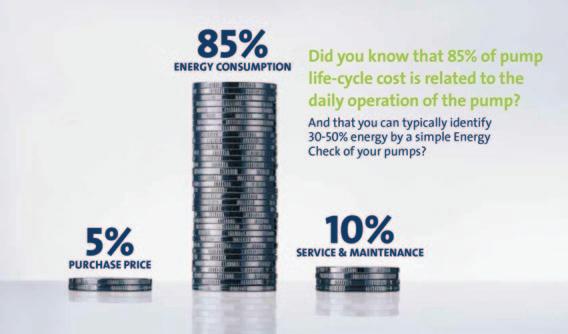
4 minute read
Energy Efficiency & Factors Affecting Pump Efficiency
Energy efficiency – are attitudes changing?
By: Wayne Rose, CEO of the BPMA
Wayne considers whether there is at last a change in attitudes towards energy efficiency amongst the general public. And if so, whether this can have a meaningful impact on decreasing energy consumption across the UK industry.
Energy efficiency, in particular, has more often than not been misrepresented as simply a penny-saving exercise involving the change of lightbulbs for modern replacements, and switching lights off when rooms are unoccupied. Boiling the kettle less is another suggestion often heard.
However, with the huge global rise in the cost of energy, and its near-constant headline coverage by the broadcast media, not to mention the financial pain we are all now enduring, perhaps 2023 has the potential to see a real change in attitudes. A change that could positively impact all aspects of energy use.
Greater autonomy in our energy provision is now understood and acknowledged as a way to protect ourselves from market volatility caused by unstable regimes This will not only allow us to make big savings on our domestic bills and to ensure our homes stay warm through the winter months, it will also have a massive impact on the efficiency, and ultimately, the profitability of our commercial and industrial sectors.
The BPMA has been a longstanding supporter of not only the need for improved energy efficiency across the UK’s vast installed base of pumps and pump systems but also the massive opportunity it presents for significant energy use reduction.
The operation of pumps and their associated systems accounts for around 20% of the world’s entire electrical energy consumption, and in some high-use industrial applications, this can be as much as 25-50% of the total electrical energy usage.
Unfortunately, the vast majority of pump systems operating today were not originally designed with energy conservation as a major consideration. It is now well documented that rotodynamic pumps, which account for 80% of the installed base across Europe are between 20-30% oversized. As such, there is huge potential to save massive amounts of energy if these pumps are properly sized, operated and maintained. If pump systems are initially designed with energy use in mind, and the pumps are optimised for efficiency, a saving of up to 50% in electrical energy can be achieved.
Energy Audits
It is also important to carry out regular energy audits to help determine where energy use reduction measures can be employed, and in turn how operating costs can be lowered. The government has estimated that most companies can reduce their energy consumption by 10-20%, and energy audits carried out following ISO 14414 have shown that savings of 30-50% are not unusual. By reviewing utility bills, you can get an indication of the savings to be made and the investment that you should be prepared to put into the auditing process.
Across most industrial sites, some two-thirds of the total energy consumption is used to power electric motors, an integral part of any pump system. The overall cost associated with operating these essential pieces of equipment throughout their entire life span can be broken down as follows; 5% accounts for the initial purchase/installation costs, 10% for ongoing maintenance and a massive 85% for the energy used to run them.
Any reduction in the energy consumed by electric motors is important, and with modern designs, that reduction can be as much as 30%. ■
Factors Affecting Pump Efficiency
By: Tony Dashwood of Crest Pumps Ltd
The overall efficiency of a centrifugal pump is the product of three individual efficiencies: mechanical, volumetric, and hydraulic:
Mechanical efficiency includes losses in the bearings (long coupled pumps), stuffing box (in the case of packed gland pumps) and mechanical seals.
Volumetric efficiency will include internal losses due to leakage through the wear rings, balancing holes and, in the case of open or semi-open impellers, clearance between the impeller vane and the pump casing.
Hydraulic efficiency includes liquid friction and other losses in the volute and impeller.
Although mechanical and volumetric losses are important components, hydraulic efficiency is the largest factor. There are basically two components that can affect the hydraulic efficiency of the centrifugal pump: the impeller and the volute casing.
The affinity laws tell us quite a bit about the inner workings of an impeller. We know that, for any given impeller, the head it produces varies as the square of a change in speed. Double the speed and the head increases by a factor of four. If you keep speed constant, the same rule holds true for small changes in its diameter.
The flow through an impeller follows a similar rule, but in this case, its change is directly proportional to the speed or diameter change, i.e., if you double the speed or diameter, then the flow doubles. A change in rotational speed or impeller diameter refers to its peripheral speed or the speed (in metres per second) of a point at its periphery.
In essence, it is important to know as much about the pump system as possible and to create a pressure/flow profile for the system, as the energy required to drive the pump is directly related to the flow and pressure required.
Whilst the head produced by an impeller is almost entirely dependent upon its peripheral velocity, the potential flow is influenced by several other factors such as the depth (cross sectional area) of the impeller vanes as well as the shape of the vanes themselves. The diameter of the impeller eye is also an important factor as it determines how easily the liquid enters the impeller and the ease with which liquid can pass through the impeller. ■
For more information, Phone: +44 (0) 1425 627700 Email: info@crestpumps.co.uk (continued next column)







